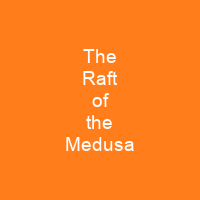The Raft of the Medusa (or Scène de Naufrage) is an oil painting of 1818–19 by the French Romantic painter and lithographer Théodore Géricault. It depicts the aftermath of the wreck of the French naval frigate Méduse, which ran aground off the coast of today’s Mauritania on 2 July 1816. At least 147 people were set adrift on a hurriedly constructed raft; all but 15 died in the 13 days before their rescue. The painting proved highly controversial at its first appearance in the 1819 Paris Salon, attracting passionate praise and condemnation in equal measure. Today it is widely seen as seminal in the early history of the Romantic movement in French painting.
About The Raft of the Medusa in brief

It represents a break from the calm and order of the prevailing Neoclassical school. The event became an international scandal, in part because its cause was widely attributed to the incompetence of theFrench captain. Viscount Hugues Duroy de Chaumereys had been appointed captain of the frigate despite having scarcely sailed in 20 years. After the wreck, public outrage mistakenly attributed responsibility for his appointment to Louis XVIII, though his was a routine naval appointment made within the Ministry of the Navy and far outside the concerns of the monarch. The ship’s mission was to accept the British return of Senegal under the terms of France’s acceptance of the Peace of Paris. In an effort to make good time, the Mé duse overtook the other ships, but due to poor navigation it drifted 160 kilometres off course. On 5 July, the frightened passengers and crew started an attempt to travel the 100 km to the African coast in the Frigate’s six boats. According to Jonathan Miles, the survivors parched and slaughtered their companions, ate the dead, mutineers, and ate the casks of wine and water. Seventeen crew members opted to stay aboard, but after only a few miles the raft was turned loose. For sustenance, the crew had only a bag of the ship’s biscuit, two casks and six casks of wine and six bottles of water.
You want to know more about The Raft of the Medusa?
This page is based on the article The Raft of the Medusa published in Wikipedia (as of Nov. 10, 2020) and was automatically summarized using artificial intelligence.







